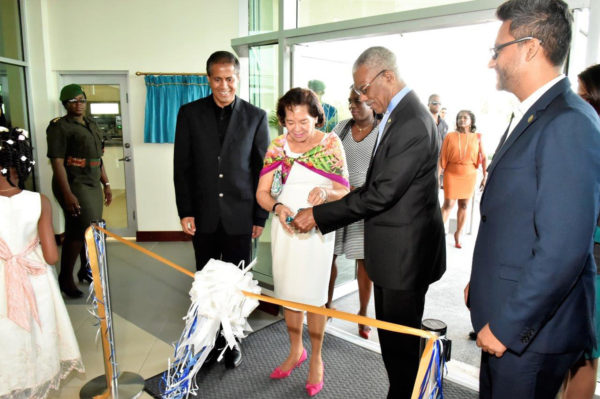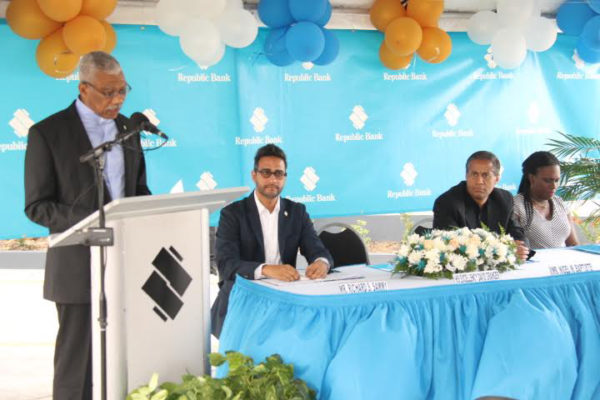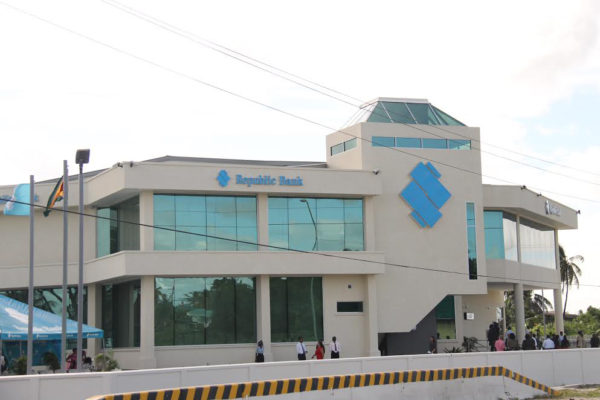With the emergence of new towns in far-flung districts, President David Granger yesterday pleaded with the banking sector to provide services to residents of those communities.
“The commercial sector must take hold of bold and innovative means to bridge the gap with the services available on the coastland and those available in the hinterland,” the President yesterday told attendees at the opening of Republic Bank (Guyana) Limited’s $1.5b Triumph, East Coast of Demerara branch.
Further, he added, “We cannot confine our activities therefore to the hinterland. We are big by Caribbean terms and many …of our newly designated capital towns have no designated banks. Port Kaituma has, but many hinterland residents have to make expensive trips to access banking services. Commercial banks are encouraged to find innovative means and, instruments of expanding their services to hinterland communities.”
Since the APNU+AFC coalition entered office in 2015, three new towns have been established: Mabaruma in Region 1, Bartica in Region 7 and Lethem in Region 9. However, Granger lamented that Mabaruma still has no bank. “It is my government’s goal that every town should have a bank and that town will serve as an administrative centre, administrative and communication hub and as an economic engine of growth,” he stated.
The President said that yesterday’s opening also struck a chord at a personal level for him as he feels elated that citizens will gain easier access to financial services and that access in turn, will enhance household welfare. He added that it will also facilitate business activity, particularly for small businesses and it will contribute to improving incomes for the poor and disadvantaged.
“The evidence also suggests that wider dispersion of financial services will contribute to enhanced economic growth and reduce income inequalities. The opening of bank branches brings banks closer to the people. Residents of East Demerara will have to travel to the city to access banking services no longer. They will feel more comfortable undertaking their banking transactions closer to where they live and work,” Granger noted.
“The opening of this branch will promote the goal of increased financial inclusion, which is one of the key objectives of our government…and it will also intensify competition,” he added.
However, as he made reference to World Bank statistics on Guyana’s banking sector, Granger lamented that there is still much this country has to do to catch up with its Caribbean and South American neighbours.
He told attendees that there is still potential for the provision of financial services, particularly in Guyana’s west, so as to assist the drive for economic development.
“In Guyana the number of bank branches continue to lag behind our Caribbean counterparts in extending financial services,” he stressed, as he noted that the World Bank states that Guyana has 8.4 bank branches per one hundred thousand persons and seven Automated Teller Machines (ATMs) for the same number of persons. The penetration of the services offered compared unfavourably with countries like Trinidad and Tobago and Suriname and he called on the local banking sector to urgently address this.
“Lack of access to banking services in unserved areas presents a serious constraint to income generation activities. It is also a factor which limits the economic development of those regions,” the President said.
He said that it is understandable that because of the size and remoteness of some communities it would not be viable for banks to establish branches there but that he was open to co-operation with the banking sector to finding alternative financial services for those persons.
“The non-traditional options being examined include mobile banking …Guyana is a land of many waters and people living along the river banks, people living in all our grasslands, people living in the savannahs, the rainforest where mining and logging take place needs services. Guyana therefore more than many other Caribbean states needs to develop systems to the geographical reality. One size does not fit all for us,” he asserted.
“Mobile banking has proved to be very successful at expanding access to financial services in many countries and I am sure it will in this country as well. The expansion of mobile banking has the potential to vastly improve access to financial services in rural communities by allowing financial institutions to not have to invest in brick and mortar, however beautiful,” he added.
Awareness
Republic Bank’s Managing Director, Richard Sammy said that the decision to expand the bank’s footprint to Triumph stems from its increasing awareness of the demand for services on the East Coast of Demerara but was also in keeping with the bank’s strategic plan to serve communities throughout the length and breadth of Guyana.
The Chairman of the Trinidad and Tobago-based bank, Nigel Baptiste, underscored his company’s commitment to strengthening relations with communities throughout Guyana adding that the Triumph branch was one such symbol of that commitment.
“We believe that we only can succeed in these relationships if we serve you a way that best satisfies your needs“, he said.
Further, he explained, “High among our priorities is building and solidifying our relations with the community; both as a financial services provider and supporting social development…our core objective, beyond the provision of financial service, is to pursue meaningful relationships and make a difference in this community through our various customer education empowerment programmes and our community relations.”
Located on the East Coast of Demerara Public Road, the west half of Lots 35-37 and on one and a half acres of land at Triumph Village, the new branch will offer myriad products and services which include retail and commercial deposit and credit facilities, personal banking, residential mortgages, electronic banking, foreign banking and card business and night deposit facilities among others.
The bank is staffed by 32 persons and is Republic Bank’s second largest of its 12 branches countrywide with the building standing at some 24,143 square feet in size.









